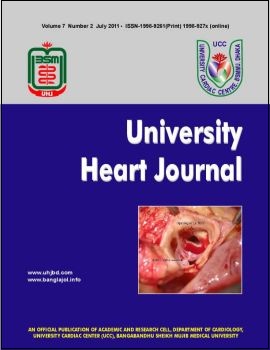Erythrocyte Glutathione Level in Patients of Acute Myocardial Infarction
DOI:
https://doi.org/10.3329/uhj.v7i2.10750Keywords:
Acute myocardial infarction, erythrocyte glutathione, malondialdehydeAbstract
Myocardial infarction is an imbalance between pro-oxidants and antioxidants. Increase oxidative stress leads lipid peroxidation and malondialdehyde (MDA) is the stable end product of lipid peroxidation. But erythrocyte glutathione (GSH) plays an important role in auto-oxidation of oxygen free radicals (OFR), this study was conducted to determine erythrocyte antioxidant level by measuring erythrocyte glutathione (GSH) in patients of acute myocardial infarction (AMI). GSH level was measured by Ellmann method, plasma malondialdehyde (MDA) level was estimated by Yagi method 25 AMI patients and 25 healthy controls of 40- 70 years in both sexes were included according to inclusion and exclusion criteria. Erythrocyte glutathione level was significantly decreased (p < 0.001) and plasma MDA level was significantly increased (p < 0.001) in AMI patients in comparison to healthy control. On the other hand, total cholesterol, triglyceride and LDL-C were significantly higher (p < 0.001) and HDL-C was significantly lower (p < 0.01) in "I patients as compared to control. This study was found a significant correlation between MDA and GSH levels (r =-0.94, p < 0.001). In AMI GSH level is reduced to scavenge the. ROS. As reduced antioxidant level may be associated with enhanced protective mechanism agtainst oxidative stress, erythrocyte GSH level may be use as an important cardiac marker in AMI.
DOI: http://dx.doi.org/10.3329/uhj.v7i2.10750
University Heart. Journal Vol. 7, No. 2, July 2011
Downloads
167
164




